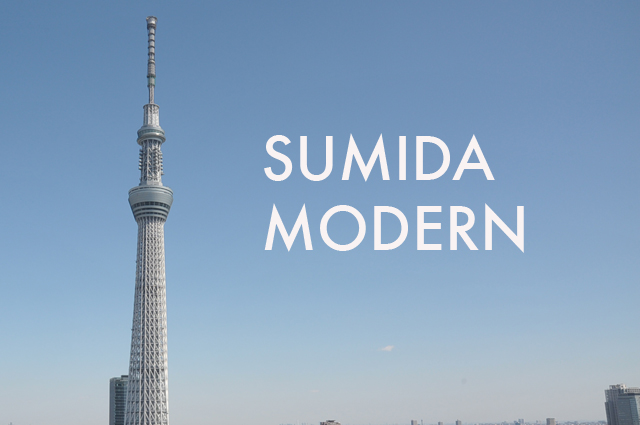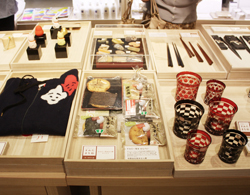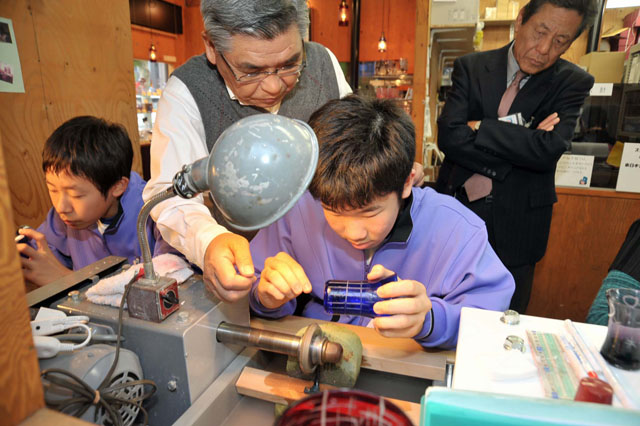What do TOKYO SKYTREE and Hokusai’s “36 Views of Mt. Fuji” have in common?
“Not much,” you’d probably say. But it turns out that both of these great works, separated by more than a hundred and eighty years (and several hundred meters!), are both famous products of Sumida. One of Tokyo’s 23 special wards, it may not have the modern fashion of Harajuku or Ginza’s glitz, but this shitamachi (downtown) city has an unpretentious ambience and a small-town charm. It’s also a centuries-old center of craftsmanship that has been given a shot in the arm thanks to development of the world’s tallest tower. One example of this development is the “Sumida Modern” project, which is infusing the techniques of traditional craft with the concepts of contemporary design.
Sumida was created when two smaller wards—Mukojima and Honjo—were merged in 1947. These two towns had very different characters, a difference you can tell even today as you walk around town: Honjo, the southern part of the city, has a neat, wide grid of streets that reveal its factory background, which dates back to the samurai residences of the Edo period. The narrow, curved streets and cherry-lined riverbanks of Mukojima, to the north, were part of a fertile farming area during the Edo period, and a favorite location for Tokugawa shoguns for boating on the Sumida River and taking their falcons hunting. As a symbol of the connection between natural beauty and the work of industry, SKYTREE stands nearly on the border of these historical towns.
Culture and History
Home to a long tradition of cultural activities famous inside and outside Japan, this town lights up the nights and tips the scales with some heavyweights—athletic and artistic. One of the largest firework festivals in Tokyo is the Sumidagawa hanabi taikai, held on the Sumida River, and like most fireworks events in Japan, it used to be competitive, with teams doing their best to get the most appreciation from the crowd. Now, the event draws nearly one million people each year to see the night sky light up with “fire flowers” in every shade of the rainbow, and in shapes that vary from smileys to anime characters.
After Mt. Fuji, one of the typical images that will come to your head when you think Japan is an outsized sumo wrestler, and sumo has been a part of Sumida’s culture for more than 200 years. Seeing the younger trainees biking around, and occasionally bumping into some of the top-ranked wrestlers is not a rare thing here. And, if you’re interested in trying to bulk yourself up to sumo size for a couple of hours, you can try the same dish that the big fellows eat to help put on weight: chanko nabe, a hearty dish of meat, fish, and vegetables, cooked in a pot and eaten family style. There are many restaurants around Ryogoku—the neighborhood that is home to the Kokugikan Sumo Stadium—that specialize in chanko nabe. And let’s go back to Mt. Fuji: some of the most iconic images of the famous peak were created by Katsushika Hokusai in his “36 Views of Mt. Fuji,” which examines Fuji-san from near and far, with different parts of Kanto as a backdrop. Hokusai was a native son of Sumida, living and working here for most of his life.
Sumida Modern and the Community
Of course, there is also a strong crafts tradition in this city, with some of the more notable handicrafts being cut glass, usually in the form of cups and vases, and carved tortoiseshell. But the “Sumida Modern” movement has a mission to take these traditional crafts, including food products, and make them useful for today’s consumers. They describe the concept as “Nostalgic, yet New.” One example of this concept in execution would be a traditional craft such as lacquerwork, or urushi, and one way of using this craft in a modern style would be making a lacquerwork paper coaster: “nostalgic” tradition, but very new usage. The branding certification requires high standards—of quality, design, and innovation—for the products sold under this brand. These authenticated products range from elegant kimono fabric and metalwork business card holders to more humble products, such as erasers that don’t leave those annoying fragments behind and whimsical paper craft insects.
But it’s one thing to support artisans who already have a passion for the craft that they work in: to keep an crafts tradition growing, you need to make sure that people in the community appreciate these traditions, and that younger generations will be inspired to learn more about them, and continue to innovate, while maintaining the traditions that have been passed along. With this goal in mind Sumida Modern has established “Sumifa,” and Sumida City has established a program that gives junior high school students the chance to get involved with manufacturing first hand.
The name Sumifa comes from Sumida + Factory tour. In the Sumifa program, participants can visit factories and galleries around the area to see how products are really made, listen to talks and presentations by manufacturers, and—because “crafts” don’t always need to be things you appreciate just with your eyes—drop in on a variety of partnering restaurants and cafes. This fall, Sumifa activities will be taking place on November 8 and 9, and for more information, you can visit www.sumifa.jp
The second program lets junior high school students learn how some of the Sumida Modern products are made, and get some hands-on experience themselves. The schools program takes place over three days, during which students learn about branding, and see how products are manufactured, packed, and sold.
After reading about Sumida Modern, you might be wondering where you could buy these products, or at least see them in person. TOKYO Solamachi, the shopping area at the base of SKYTREE, is where you can find Sumida City Point, a store that carries many of the items that are sold under the Sumida Modern brand.
For more information about Sumida Modern please visit their official website: sumida-brand.jp










